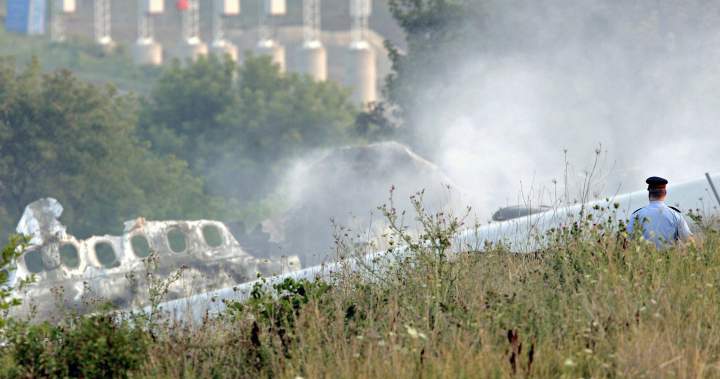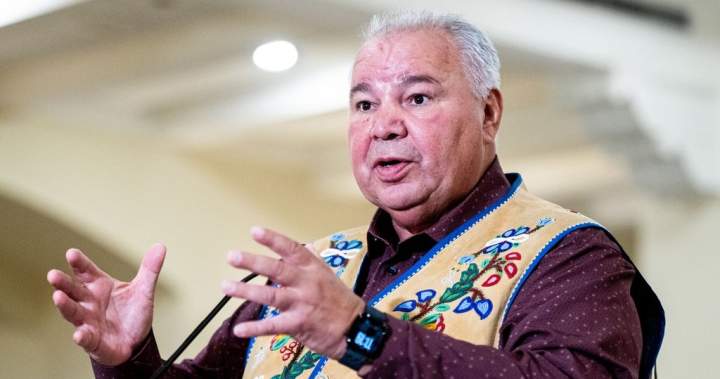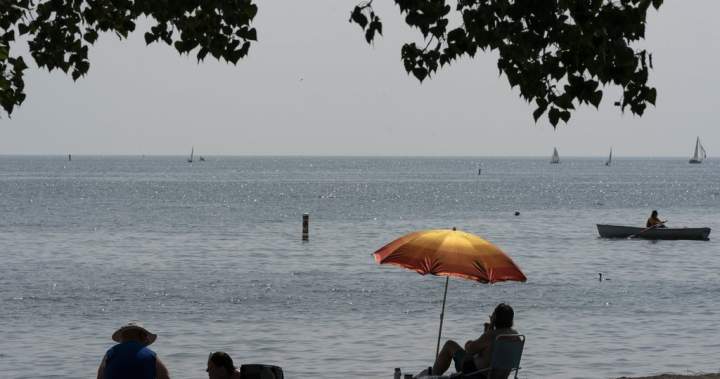Uncategorized
Survivors recall frantic escape 20 years after Air France crash in Toronto

Lisa Platt was returning to Toronto with a French exchange student on Air France flight 358 on Aug. 2, 2005.
At 15, Platt hadn’t travelled by air very much at that point and was enjoying the trip.
“We were all excited, wearing headphones, listening to the same music. It was a great day,” said Platt.
Eddie Ho, age 19, was a business student from South Africa attending Queen’s University in Kingston. He also said the trip from Paris was memorable.
“The service was great, the food was great, it was actually a very enjoyable flight,” Ho said.
But it was a flight that ended with the plane going up in flames after a disastrous landing, even though it initially appeared to passengers that the pilots would be able to stop on the runway 24L at Pearson International Airport in Toronto.
“I felt a huge impact like you were on a roller-coaster,” said Platt.
“The plane was making its way down the runway and everybody started clapping. Nobody knew what was going to happen after that,” said Ho.
Lisa Platt and Eddie Ho are pictured in downtown Toronto in July 2025.
Sean O’Shea/Global News
According to the aviation investigation report by the Transportation Safety Board of Canada, weather conditions for the landing included “very dark clouds, turbulence and heavy rain.”
“The runway was covered with water, producing a shiny, glass-like surface,” the report continued.
The Air France Airbus A340 touched down “3,800 feet down the 9,000 foot runway” and was not able to stop, crash investigators concluded.
“It departed the end of the runway at a groundspeed of 80 knots (148 kilometres per hour) and came to rest in a ravine,” the TSB report said.
Seconds after the plane came to a stop, fire was observed out the left side of the aircraft and smoke was entering the cabin, the report said.
For passengers, including Ho and Platt, it was clear they needed to get out of the plane immediately.
“Some people were reaching up for their bags and others who were in the middle of the plane, they knew what was going on, and they were climbing over seats pushing people out,” said Ho, who was seated in the economy cabin just behind the business class section.
When Ho went to the nearest exit to get out, he discovered that the emergency evacuation slide hadn’t deployed. He faced a choice: jump to the ground and risk injury or look for another way out.
“I decided not to risk the jump; I ran to the front to the first exit on the left,” he said.
At the second emergency exit, Ho said he faced another challenge.
“The chute came out, but it did not inflate. But at that point I had no other choice,” said Ho, who jumped and sustained minor injuries.
“There were passengers near me who broke their hips, broke their legs, had much more serious injuries.”
Platt, seated with her friend toward the rear of the plane, had an easier time escaping.

Get daily National news
Get the day’s top news, political, economic, and current affairs headlines, delivered to your inbox once a day.
“My shoe popped off. I remember grabbing my shoe with my hand thinking, ‘I’m going to need this,’” Platt said.
After descending on the escape slide, Platt observed a passenger concerned about what he left behind.
“I remember a guy in a brown suit worried about his luggage at the bottom of the chute, and I thought, that’s not the right time to worry about your luggage,” Platt said.
Police survey the site where an Air France Airbus A340 jet slid off the runway and crashed at Toronto Pearson International Airport in Toronto, Wednesday, Aug. 3, 2005. All 309 passengers and crew aboard the Air France jet survived the crash Tuesday afternoon.
David Duprey/AP via CP
Ho, Platt, and others made it out of the plane, but weren’t out of danger yet.
“My first thought was, we have to get away from the plane because it’s going to explode,” he said.
“We need to get away.”
Ho said he and another man assisted an injured passenger lying on the ground.
“(We were) carrying him, just trying to drag him away from the plane,” said Ho.
About the same time, Ho pulled out his Canon Powershot digital camera and quickly grabbed a few frames of the burning airplane as he moved away. At the time, smart phones hadn’t been invented and few people carried cameras every day.
“I remember taking a couple of shots, I didn’t aim or do anything, I just took it out and snap, snap,” said Ho. One of his pictures was awarded the 2006 Canadian Press Picture of the Year in the news category.
Eventually, Ho was transported to the Pearson air terminal where he joined other plane crash survivors who were grouped together.
“They actually thought it was a terrorist attack, so they didn’t let any passengers out,” Ho said.
Even though Ho and Platt had abandoned their belongings in the aircraft, that fact didn’t prevent customs officers from wanting to know what they had brought back from Europe.
“I still remember the customs folks, CBSA (Canada Border Services Agency) came out and asked me multiple times: ‘Do you have anything to declare,’” and insisted he sign a declaration card.
“I had nothing to declare,” Ho said.
Platt said she, too was asked to make a declaration.
“They were just doing their jobs,” she said.
With news of the Air France crash making headlines around the world, Platt wanted to let her family know she was all right.
She reached her mother by telephone.
“I was like, ‘Mom, it’s me, it’s Lisa,’ recalling how her mother appeared surprised and probably relieved to hear her voice.
Late that evening, Platt and others were allowed to leave after the airline had accounted for all the passengers and crew members.
“We were pretty sure there were fatalities,” said Ho, recounting what he felt in the hours after the crash.
Lisa Platt shows a tattoo on her ankle of AF 358, the number of an Air France flight that crashed at Toronto Pearson International Airport on Aug. 2, 2005.
To the surprise of many who were onboard, all 297 passengers and 12 crew members had made it out safely.
Everyone survived.
But quickly, many passengers would start dealing with the aftermath.
“It was exhausting, I think it was the next day when it all hit me,” said Platt.
In the months and years ahead, the survivors would come to terms with what they had gone through that afternoon in the driving rain and lightning at the end of the runway.
Ho and Platt experienced post-traumatic stress disorder (PTSD) and sought help from therapists for about a year.
“I remember I started to get nightmares, and I slowly didn’t like to be on buses, I didn’t like to be in cars,” said Platt.
To this day, Platt says she must be the one driving a vehicle in a rainstorm.
At the end of her counselling sessions, Platt says her therapist would hold her feet for about five minutes, encouraging her to stay grounded.
Platt later had the Air France flight number, AF 358, tattooed on her ankle, a daily reminder of what she had survived.
Air France provided a free, return trip to every passenger on the ill-fated flight. Platt chose to travel back to Paris and to return to Toronto exactly one year later on the same day and flight.
“I cried and you grip harder than you normally grip,” she said, referring to holding on to the armrests.
Years later, Platt went on to pursue a career that might be considered unusual for an air crash survivor.
“I thought, ‘I want to be a flight attendant, I want to get on these planes and I can do this,’” Platt said.
After initially working as a customer service representative, Platt got a job as a flight attendant with Porter Airlines. She spent almost ten years with the company flying in and out of Toronto before pursuing another career.
Eddie Ho finished his university education and became a chartered professional account in Toronto.
He says he took his first flight a year after the crash but it took about five years before he stopped thinking about the crash when he boarded a plane.
As a frequent flyer for work, Ho says he tries to put other jittery flyers at ease when he can.
“Sometimes it’s a passenger next to me and they’re afraid of flying,” said Ho.
“‘I’ll give them support right away, don’t worry, it will be fine,” he tells nervous passengers.
Ho holds something back, however.
“I don’t tell them that I’ve been in a plane accident. I usually tell them afterward,” said Ho.
Ho lets people know that crash survivors don’t get free perks beyond that initial free flight.
“The stories that you get free, unlimited travel for the rest of your life or free elite status for the rest of your life, no, that doesn’t happen,” he said.
Ho said the crash has influenced how he approaches life.
“I have a mindset of — how can I help others?” and says he does not hold grudges as a result of the crash.
Similarly, Platt recalls how fortunate she is to have escaped death 20 years ago.
“I have a lot of gratitude. I am very thankful we made it out okay,” said Platt.
“For me, things may have been different if we didn’t all survive.”
Uncategorized
Indigenous groups question government funding for Métis Nation of Ontario

First Nations in Ontario and the Manitoba Métis Federation say nearly $1 billion in federal funding went to a group they allege is fraudulently claiming Métis identity.
The Chiefs of Ontario, which represents 133 First Nations in the province, shared with The Canadian Press data on more than 20 years worth of federal funding provided to the Métis Nation of Ontario.
It suggests that $819,836,061 went from Ottawa to the MNO — an organization First Nations leaders say has no legitimacy and threatens their rights.
“This data shows just how badly First Nations in Ontario are being harmed by the diversion of government funding to the MNO and away from the needs of First Nations and other legitimate groups,” the Chiefs of Ontario said in a media statement.
“The question is, why is the Crown sending hundreds of millions of dollars to the MNO when there is overwhelming evidence contradicting their claims?”
The data indicates the money came from several federal departments, including Indigenous Services Canada, Crown-Indigenous Relations, Parks Canada and Environment and Climate Change Canada.
The MNO also received funds from the Canadian Nuclear Safety Commission and the Impact Assessment Agency related to the potential impacts of projects in their communities.
The conflict between First Nations, some Métis groups and the MNO stems from a 2017 decision by the government of Ontario to recognize six “new, historic” Métis communities in the province — and a 2023 federal government bill, which never passed, that would have affirmed the MNO’s right to self-government.
First Nations and other Métis groups say the communities represented by the MNO have no claim to Métis heritage and Ottawa and Ontario have no right to recognize them.

Last month, history professor Leila Inksetter of the University of Quebec in Montreal released a report drafted on behalf of the Wabun Tribal Council that concluded there is no evidence of a mixed-ancestry community in the Wabun Tribal Council’s territory in northeastern Ontario.
The MNO rejected that report, saying that despite years of outside attempts “to discredit” it, “nothing has changed.”

Get breaking National news
For news impacting Canada and around the world, sign up for breaking news alerts delivered directly to you when they happen.
“The facts of history will not change because a new ‘expert’ has been paid to peddle the same Métis denialism,” the group said in a media statement.
The MNO has cited a 2003 decision by the Supreme Court of Canada to recognize a Métis community in and around Sault Ste. Marie, Ont. The case did not consider the six new communities recognized in 2017, but rather what may constitute a Métis right.
Another report, published last month and commissioned by Saugeen Ojibway Nation, also concluded there is no evidence of a distinct Métis community in their territory in southwestern Ontario.
“The historical evidence simply does not support this claim,” says the nearly 200-page report, written by two historians at the University of Toronto.
While the report says there were “certainly individuals and families of mixed ancestry” in the region, that can’t form the basis of a claim to a distinct community within Saugeen Ojibway Nation territory.

Jennifer St. Germain, MNO chief strategy officer, said Métis and First Nations “should not be working at odds as we are not enemies.”
“We have worked together throughout our shared history to push colonial governments to respect the rights of Métis and First Nations peoples, to properly invest in the programs that matter to our families and communities, and to uphold the honour of the Crown,” she said.
“When the MNO and Ontario First Nations work together, we make real change for the better for our children, families, and communities, as well as our lands and waters.
“It’s time to get back to the table rooted in our shared values of honesty, truth, and respect.”
The Chiefs of Ontario says that the academic research “merely reaffirms reality.”
“Not only are Ontario and Canada refusing to consult First Nations, they refuse to share the research they relied on or acknowledge the growing body of research and take steps to fix their mistakes,” the Chiefs of Ontario said in a media statement.
“It is extremely disappointing that Canada and Ontario … failed to do any adequate research before recognizing the MNO.”
Open disputes over claims to Métis heritage came close last year to ripping apart the Métis National Council, which once acted as a national voice for Métis but now has just two provincial members.
The Métis Nation-Saskatchewan withdrew from the Métis National Council last September, citing concerns about the MNO and claiming the council had failed to ensure the integrity of its citizenship registry.

The Métis Nation British Columbia withdrew from the council shortly after, saying it had lost confidence in the council’s ability to serve as a national advocacy organization.
Their departure came years after the Manitoba Métis Federation withdrew from the council, citing similar concerns.
Will Goodon, the Manitoba Métis Federation’s minister of identity protection and inter-Indigenous affairs, said the amount of public money available to Métis communities is limited and should not be shared with bodies that are not connected to what he calls the historic Métis Nation — largely recognized as descendants of the Red River communities in Manitoba.
One Parks Canada grant received by the MNO was meant to allow the organization to secure land and “support creation of an ecological corridor in the region along the north shore of Lake Superior,” says a federal document.
Goodon said that type of funding raises red flags for both Red River Métis and First Nations concerned about the prospect of the MNO seeking land in their territories.

The Manitoba Métis Federation said it’s also troubled by the fact that the federal government last week invited MNO leaders to a meeting to discuss its controversial major projects legislation.
The federation, which boycotted that meeting, said the MNO’s invitation undermined the integrity of the gathering and put the government’s major projects agenda at risk.
“Canada and Ontario are pushing pro-development agendas. They say they will consult with ‘Indigenous communities’ but, in Ontario, the only consultations that should occur are with the rights holders — First Nations,” the Chiefs of Ontario said in a media statement.
“Pan-Indigenous approaches do not work and only devalue the true rights holders.”
© 2025 The Canadian Press
Uncategorized
Landlord says B.C. billionaire’s plan for Bay properties ‘defies commercial common sense’

Cadillac Fairview says a plan from a B.C. billionaire hoping to take over 25 former Hudson’s Bay leases “defies commercial common sense” and thus, she should not be allowed to move in.
In filings made with the Ontario Superior Court on Saturday, Cadillac Fairview says it is “resolutely opposed” to Ruby Liu becoming a tenant at some of its malls because she has no detailed or credible business plan.
The mall owner also says Liu, who owns three B.C. shopping centres herself, has no brand, experienced staff or track record in retail.
Her business is “an empty shell without any guarantee of financial means beyond Ms. Liu’s bare assertion that she will keep it afloat,” said Rory MacLeod, Cadillac Fairview’s executive vice-president of operations, in an affidavit. “All of the indications are that (her company) will run out of money before the first store opens.”
MacLeod’s affidavit ups the ante in a battle that has been festering between Liu and landlords since the Bay announced in May that it had chosen her to buy 28 of its leases. The first three got court approval and were transferred in short order because they were at Liu’s three malls.

The remaining 25, however, have been much more fraught. Those leases cover some of the country’s most prized retail space and came with cheaper rent and very attractive terms for the Bay, which filed for creditor protection under the weight of tremendous debt in March.
For example, the Bay paid $1.3 million in annual rent for 152,420 square feet at Fairview Mall in Toronto, court documents show, which is a fraction of what non-anchor tenants would pay.

Get breaking National news
For news impacting Canada and around the world, sign up for breaking news alerts delivered directly to you when they happen.
Unable to get most landlords onside with a lease transfer, the Bay asked a court at the end of July to force property owners to accept Liu as a tenant.
Liu and the Bay have until next Tuesday to respond to Cadillac Fairview’s allegations. A judge will hear the matter at the end of the month.
Liu has said she wants to turn the Bay stores she is hoping to buy into her own department store named after herself. She has repeatedly told The Canadian Press her stores will not just offer retail space but also dining, entertainment, kids play and recreation areas.
MacLeod says she’s also talked of outfitting Bay spaces with grocery stores, educational centres, senior’s facilities, robotics and musical performances.
Cadillac Fairview says leases at the six malls she wants from the company — Fairview Mall, Sherway Gardens, Masonville Place and Markville in Ontario, Market Mall and Chinook Centre in Alberta and Richmond Centre in B.C. — don’t allow for anything other than a department store to be operated there.

“Despite her private assurances that she intends to respect the lease terms, Ms. Liu has consistently presented a different idea to the public, one that would not be compatible with the leases,” MacLeod said.
His affidavit also raised concerns with the timelines and budget in her business plan.
Liu has said she will be ready to open at least 20 stores within 180 days of obtaining leases and will spend $120 million on “overdue” repairs to roofs, HVAC systems, washrooms, elevators and escalators and $135 million on initial inventory.
Cadillac Fairview says her proposed timeline is “entirely unrealistic” for a new brand, let alone an established one, and her plan is underfunded based on the high number of repairs properties need and expensive terms suppliers will require her to agree to.
MacLeod estimates the stores will need more than $15.8 million in repairs before the end of 2026 to bring the leases into good standing. By 2027, Liu will need to spend another $5.7 million on repairs, not including taxes, permits or fees for expedited labour.
Over the next 10 years, he estimates Liu will be required to spend at least $43.1 million on the Cadillac Fairview leases alone.
He also took issue with her staffing estimations, which show she will need 1,800 employees to carry out her plan.
If all 1,800 are sales staff that would only leave 64 people on the floor of each of her 28 stores. Macleod said such staffing levels are “inadequate to support a countrywide chain” and “inconsistent with a retail location even a fraction of that size.”
“With my decades of experience in commercial real estate, it is apparent to me and Cadillac Fairview that (Liu) will fail and again leave these stores vacant,” he said.
© 2025 The Canadian Press
Uncategorized
Heat warning issued for large part of Ontario, Quebec

A heat warning has been issued for a large part of Ontario and Quebec, with the hot weather expected to last multiple days, Environment Canada reports.
Daytime highs of 30 to 35 C are expected with the humidex values of 35 to 40 C.
Overnight lows will be cooler but will still hover between 19 to 22 C.

Get breaking National news
For news impacting Canada and around the world, sign up for breaking news alerts delivered directly to you when they happen.
Temperatures are expected to cool mid-week, which will start to bring an end to the heat, Environment Canada said.
The organization warns that extreme heat can affect everyone’s health and people should check on older adults, especially those living alone and other at-risk people.
Signs of heat exhaustion might include headache, nausea, dizziness, thirst, dark urine and intense fatigue.
Call 911 or your emergency health provider if you, or someone around you, is showing signs of heat stroke, which can include red and hot skin, dizziness, nausea, confusion and change in consciousness.
Environment Canada says heat warnings are issued when very high temperature or humidity conditions are expected to pose an elevated risk of heat illnesses, such as heat stroke or heat exhaustion.
© 2025 Global News, a division of Corus Entertainment Inc.
-

 Uncategorized2 months ago
Uncategorized2 months agoAccording to Dior Couture, this taboo fashion accessory is back
-

 Uncategorized2 months ago
Uncategorized2 months agoThese ’90s fashion trends are making a comeback in 2017
-

 Uncategorized2 months ago
Uncategorized2 months agoThe old and New Edition cast comes together to perform
-

 Uncategorized2 months ago
Uncategorized2 months agoUber and Lyft are finally available in all of New York State
-

 Uncategorized2 months ago
Uncategorized2 months agoNew Season 8 Walking Dead trailer flashes forward in time
-

 Uncategorized2 months ago
Uncategorized2 months agoMeet Superman’s grandfather in new trailer for Krypton
-

 Uncategorized2 months ago
Uncategorized2 months ago6 Stunning new co-working spaces around the globe
-

 Uncategorized2 months ago
Uncategorized2 months agoThe final 6 ‘Game of Thrones’ episodes might feel like a full season








